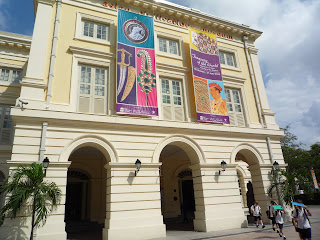 Above: Signboard at the Asian Civilisations Museum
Above: Signboard at the Asian Civilisations MuseumPrior to my Cultural Creative Team 12th March visit to the Asian Civilisations Museum (ACM), I took some time to research on the background of the Asian Civilisations Museum.
A 5 minutes walk from the Raffles Place MRT Station, the museum overlooks the historic Singapore River. Designed by colonial engineer JFA McNair in the 1860s, and built by convict labour, the neo-Palladian architectural style building at Empress Place was on 2nd March 2003 as the Asian Civilisations Museum, after a long run as a government office and the Empress Place Museum.

Above: Entrance of ACM- with highly symmetrical neo-Palladian structure and arches
The move was designed by National Heritage Board to promote better appreciation of Singapore’s multi-ethnic society, presenting a broad and integrated perspective of pan-Asian cultures and civilisations.
 Above: Stairs leading to the Singapore River Gallery
Above: Stairs leading to the Singapore River Gallery Below: Hall at ACM

Despite spanning 11 galleries and 3 storeys, with attractive banners which hung across the beige facade of the museum, we zoomed in on the Singapore River Gallery on the 1st Floor. Wooden stairs adorned with silver handrails led to Gallery 1. It was airy, had high-ceilings, and decorated with stately Doric columns and pilasters, enhancing the neo-Palladian architectural style. The gallery is aptly located as through the glass windows, views of the Singapore River were captivating, and one can compare the changes in the landscape of the river, “side-by-side”.
Although it was easy finding the gallery, it was difficult to navigate as paths were narrow and winding. The interactive ExplorAsian zones incorporated with the exhibits were unique and depicted the lifestyle of main ethnic groups living by the river. It showed that our multi-ethnic, multi-racial society can be traced back to the colonial times.

Left: ExplorAsian Interactive Zones

Above:“Model of the Labourers’ quarters or Coolie Keng”
Out of all artefacts in the gallery, my favourite was “Model of the Labourers’ quarters or Coolie Keng”. Singapore River has been the life-blood of our island for more than 600 years, and trade brought sophistication and wealth to Singapore. Yet those who made Singapore River a bustling place lived simple lifestyles and most had suffered from poor living conditions, opium addiction and gruelling work. These coolies had toiled on daily doing back breaking tasks such as loading and unloading heavy cargo from the sampans. They were given opium to help relieve their tired bodies and gambled to escape from their misery. Their hard work formed the backbone of Singapore’s economy, and life was tough, their sense of camaraderie is commendable. Likewise, Singaporeans do care for one another, and we often donate to charity organizations to help those less fortunate or the victims of natural disasters.
 Left: Coolie Keng
Left: Coolie KengThese coolies are seen having a plain meal at the end of a day in their quarters, and this was where they listened to one another’s life stories. Similarly, in Singapore, mealtimes, especially dinner, is the only time of the day where busy Singaporeans get together, to share our day’s experiences, and where family members will listen to one another’s problems and solve them. Mealtime is, and has always been more than a time to nourish ourselves, and this practice should always be continued no matter how busy we are.
Other than viewing exhibits, drop by “Museum Shop by Banyan Tree”, the spacious souvenir shop which garnered the “Best Shopping Experience Award” in 2009. Mementos for purchase range from bookmarks to carpets.

Above: Entrance to Museum Shop by Banyan Trees
There is also a café restaurant, IndoChine, situated left of the museum. It boasts excellent authentic IndoChinese cuisine, for patrons to enjoy a gastronomic and visual feast.
 Above: IndoChine Cafe
Above: IndoChine CafeMy overall experience at this museum was enjoyable and insightful; I understood the hardships faced by our ancestors through this interactive exhibit with real-life murals.
 Above: Murals at the Singapore River Gallery
Above: Murals at the Singapore River GalleryA museum definitely worth visiting!
Ticketing details and opening hours can be found at the Asian Civilisations Museum here:


I recently came across Wooden Floor Polishing while searching for the best wooden floor polishing in Delhi, and I was really impressed by their work. Their team provides professional wooden floor restoration, sanding, and polishing services with a perfect finish. The quality of craftsmanship, use of high-grade materials, and attention to every detail make them stand out. My floors now look elegant and brand new! Highly recommended for anyone in Delhi who wants reliable and affordable wooden floor polishing services. Truly the best choice for wooden floor care and maintenance.
ReplyDelete